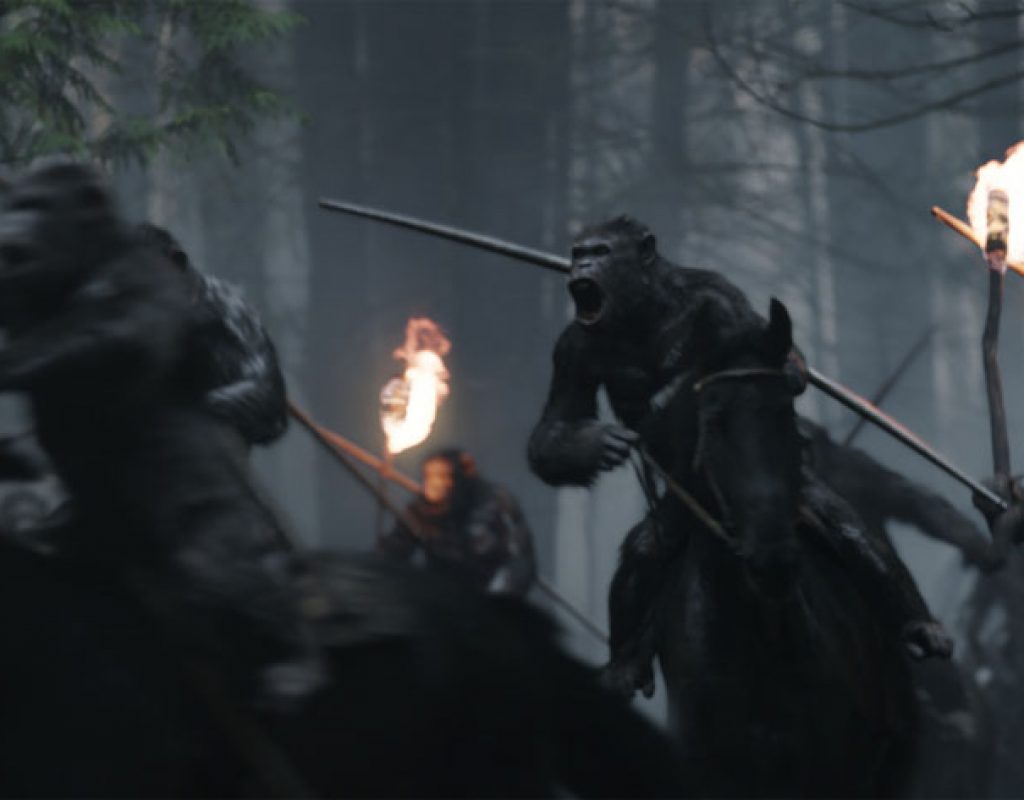William Hoy, ACE got into the editor’s seat on feature films back in the mid-‘80s. One of his first major feature films was Dances With Wolves. Since then he’s edited a string of box office and critically acclaimed hit films: Star Trek VI: The Undiscovered Country, Patriot Games, Se7en, The Man in the Iron Mask, The Bone Collector, Dawn of the Dead, Fantastic Four, 300, Watchmen, and Dawn of the Planet of the Apes. Art of the Cut caught up with William recently to discuss his work on War for the Planet of the Apes.
HULLFISH: The ape performances were obviously motion capture. What was the workflow for editing?
HOY: The genius of WETA (the visual effects company responsible for the motion capture, animation and VFX rendering) is that they can translate a human face into a simian face. If you see the motion capture performance side by side with the final animation, you’ll absolutely see every nuance that Andy Serkis had. Every little twitch. Every subtle look. The tear falling – they matched the tear falling off – that was CG but that is entirely Andy’s performance. As Matt (director, Matt Reeves) and I go through the picture, we choose the actor’s performance. This picture is different in motion capture from some other ones that I know of because the motion capture on others are shot within a virtual set, so the actors aren’t performing in the real environment. We were actually shooting scenes in the forest. We had all these “witness cams” that capture the action of the apes and then there were also cameras on their faces and they have dots all over their face and they are wearing these sensors on these gray spandex suits that looked like gray pajamas. But we’re on location and Serkis has to walk like an ape. He has to do all of the physicality of an ape. Right before picture started, Terry Notary – who was also in Rise and Dawn as Rocket – he runs Ape school. So any new actors go to this school and he teaches them how to move. They have these crutches so their movements simulate quadrupeding of apes.
All of that goes to WETA who translates their performances. The translation is amazing and it’s only gotten better through each of these pictures from Rise to Dawn. So I would come in in the morning – because WETA is in New Zealand – and I would see these shots that have come in overnight and I would be so moved because you can actually see the emotion in the performances. These apes in the animation had the performance that we originally chose from the actor. When I first started seeing the nuance coming in on this particular film, it was at another level which really was breathtaking. So the performances of our actors is basically what we work with. A huge part of the budget on this picture is visual effects and almost all of it was dedicated to performance. So that’s why I wanted to return to work another one. There is also the collaboration with Matt Reeves. It’s become easier because there’s a bit of shorthand. So I can actually take a performance and slap it on the side of captured performer’s head and Matt can look at it and understand what he’s eventually going to get.
HULLFISH: So beyond that shorthand, do you find any other value to working with the same director/editorial team?
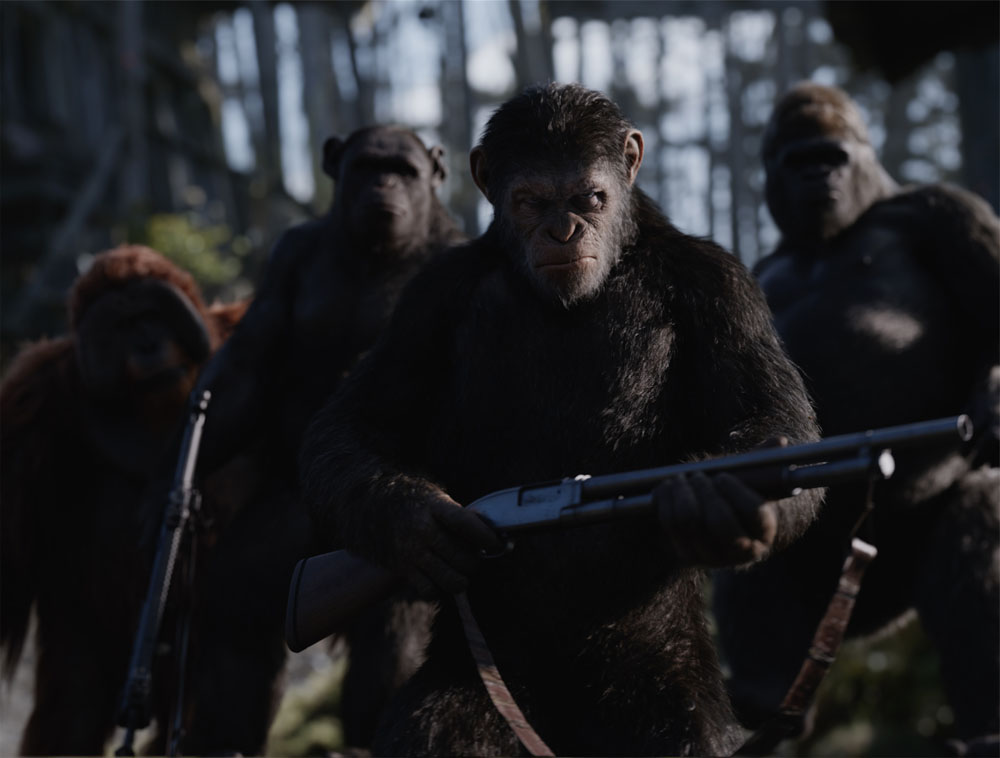
HOY: The big thing is that the director has confidence that you’ve been diligent about choosing the right performance and that you didn’t say, “I cut in the last take because I thought that’s what you were going for.” On the first one it took a while for him to trust me in that way because he’s very very meticulous. We would go through each scene and take, but on this one he accepted some of the takes that I chose without asking to look at them all again. He would say, “Oh yeah. That is the best one. I remember that.” And we could move on and spend time solving bigger problems, which is a real help because the picture was so complicated.
We shot a lot in the Pacific Northwest forest, but we also did shoot on the motion capture stage. So while they were shooting, I’m on location, but I’m actually in my editing room cutting the picture, so to spend time on the set means time away from putting the picture together. When they shot on the motion capture stage – which was very close to where the cutting rooms were – it gave me an opportunity to go down there and see how things are shaping up to see if I have something to add that early on because a lot of times those scenes haven’t been put together.
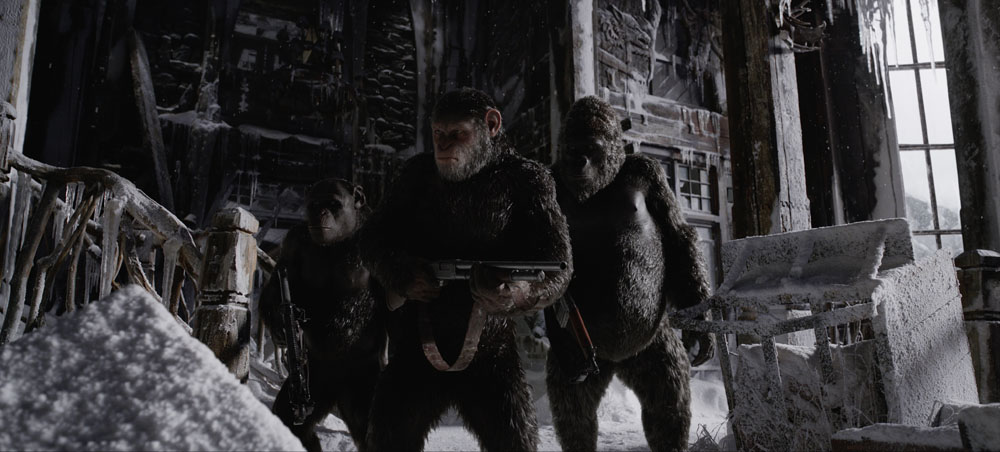 On this particular picture we held out three weeks of motion capture to be shot later because we knew we wanted to visualize some scenes first and see how everything fits in. And we knew we would want to tweak things so there were certain scenes that weren’t entirely shot in the first pass. So we waited until the picture was together and then we shot motion capture here in L.A. and I was on the set for that. We actually had our Avids out on the motion capture stage. So we could see that we need characters to run quicker or a certain character needs to enter here or for a certain performance because we need these interconnecting pieces. There’s also scenes that we had to reimagine in the cutting room, Matt and I. And so those are the scenes that we talked out extensively.
On this particular picture we held out three weeks of motion capture to be shot later because we knew we wanted to visualize some scenes first and see how everything fits in. And we knew we would want to tweak things so there were certain scenes that weren’t entirely shot in the first pass. So we waited until the picture was together and then we shot motion capture here in L.A. and I was on the set for that. We actually had our Avids out on the motion capture stage. So we could see that we need characters to run quicker or a certain character needs to enter here or for a certain performance because we need these interconnecting pieces. There’s also scenes that we had to reimagine in the cutting room, Matt and I. And so those are the scenes that we talked out extensively.
For example, “what if we just had Caesar come down the mountain here and he slid?” Because I have this amazing wide shot and wouldn’t it be nice if he slid down the mountain and caused this slight avalanche, which is kind of a precursor to what comes later? So we captured Andy doing this action on the stage. Without that, it might come out of the blue. If we had that happen, we know that the snow was unstable so WETA put in a little break in the snow.
HULLFISH: So you actually started by cutting using the motion capture footage?
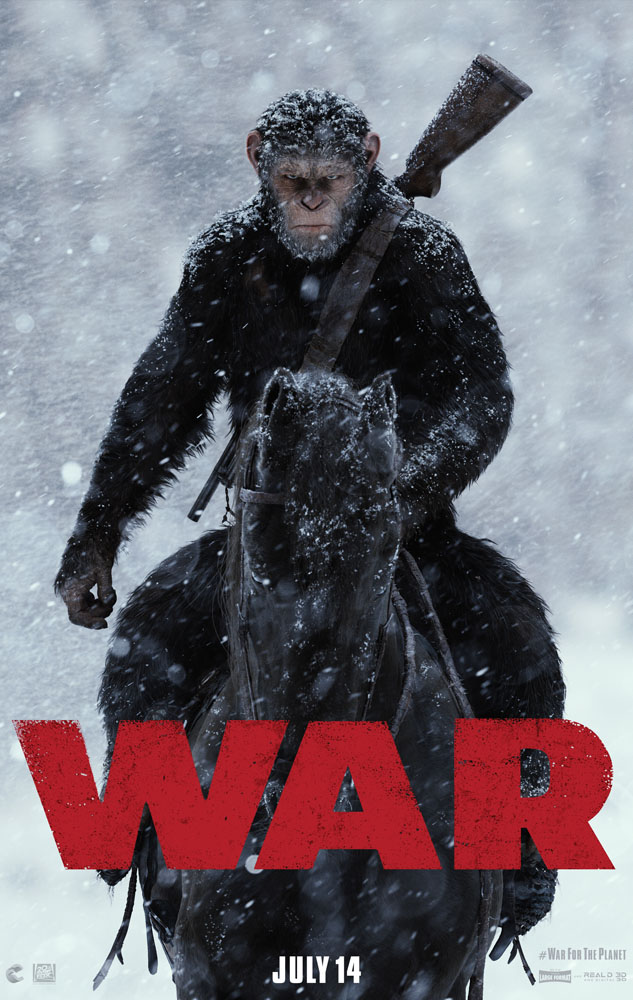 HOY: Absolutely so. I start editing the picture as soon as they finish shooting a scene with our human and motion capture actors and began crafting that scene into what I hope it ultimately would be. But in the meantime we need to begin to turn some of these visual effects over because they just take so long. And you can’t jam up WETA’s pipeline all at once: say, “OK, we’re done with the locked picture. Here are 1,400 shots.” It’s not going to happen. So we segment out with a schedule of what WETA can handle and what scenes are first. Then we would focus our attention on those scenes. We had the luxury of actually putting the picture together on this one and we could turn it over as soon as soon as Matt saw the picture, which was two weeks after we came back from location. So right after that, there were some scenes that he was happy with already, so we could send those out.
HOY: Absolutely so. I start editing the picture as soon as they finish shooting a scene with our human and motion capture actors and began crafting that scene into what I hope it ultimately would be. But in the meantime we need to begin to turn some of these visual effects over because they just take so long. And you can’t jam up WETA’s pipeline all at once: say, “OK, we’re done with the locked picture. Here are 1,400 shots.” It’s not going to happen. So we segment out with a schedule of what WETA can handle and what scenes are first. Then we would focus our attention on those scenes. We had the luxury of actually putting the picture together on this one and we could turn it over as soon as soon as Matt saw the picture, which was two weeks after we came back from location. So right after that, there were some scenes that he was happy with already, so we could send those out.
I should add to that I was on location on my own and put most of the picture together then Stan Salfas, who also worked on the last one, came onboard in Los Angeles a few weeks before we came back from location. Because the picture was so demanding – as far as time is concerned – I’d come in the morning and look at shots and then Matt would come in, we’d look at them together, discuss the progress of each shot and then we’d work on scenes together. Matt broke for dinner at about 7:00 or 8:00 and I’d continue to complete my work for the day. He would work with Stan until midnight. He’s the hardest working guy on the picture.
You’re right as far as: how do you visualize some of these performances? When they’re rendered, the performances begin to transform. We have complete faith in WETA, but you never know exactly what you’re going to get, so we have a tendency to leave things just a little long if we can – just a few frames, but when there is an action match or something like that there’s nothing you can do. We just go on the faith that we picked the right frame.
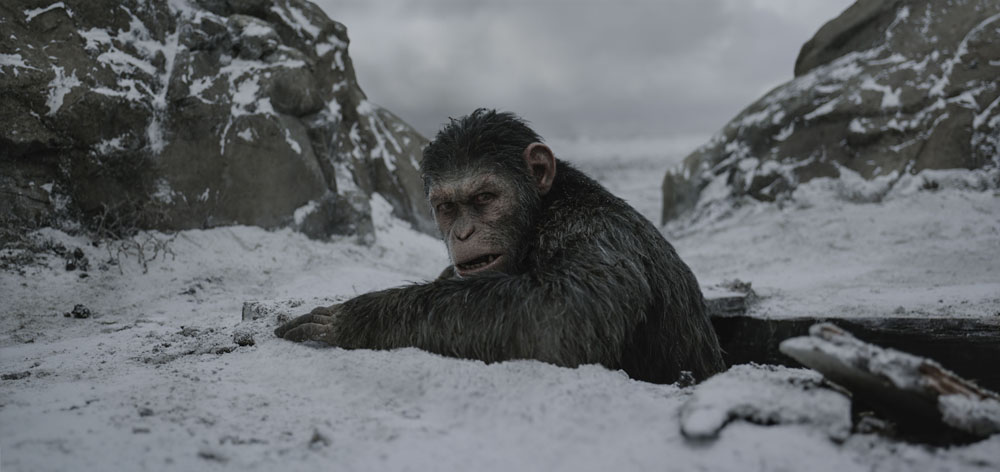
As the picture evolves, and you begin to see some of these rendered apes in their final form, we found that we could drop some of the music, because we didn’t need that music to tell us how to feel about the apes at this point in the story. When we’re at a more primitive state, technically, we had a tendency to load the picture up with temp music. But when we came to the final mix, we started stripping out music and just letting these characters play, because they’re so real and they give you everything you would want from an actor. You just look in their eyes and say, “Oh My God! I get it!” We don’t need all this dressing. As a matter of fact, sometimes the music made it too melodramatic. Sometimes it telegraphed an idea. So we were kind of showing our hand before the climax or the point of the scene.
We put this together with motion capture characters and then we have to screen it. So I look at it with Matt and he says, “Yeah that’s working pretty good.” But how do we represent this in a screening? The characters are looking the wrong way or we had elements of a scene that did not exist at that point. We had VFX editors who would actually cut heads out and put it in where needed. We know that ultimately WETA is going to make that seamless. But, how do you show that to the studio? How do you show that to an audience and get the emotional reaction that you want? So there’s another step which doesn’t lead to the final step, but it’s a side step that we need to take because none of this will end up in the final, it’s just for screening. Our VFX producer, Ryan Stafford, knew this from working on Rise and Dawn. He knew to have a whole crew of post-viz artists, so they could depict these in more detail.
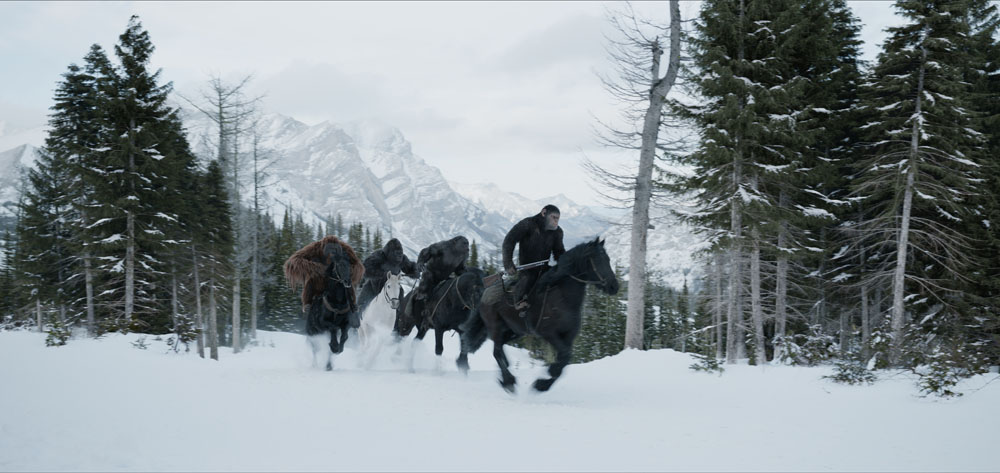 We had what we call “ape puppets” – something to represent a character be it Caesar if he’s riding a horse – we were able to put this ape puppet on there and put “Caesar” on his chest, and have him riding on the horse. Ultimately we know that’s going to be a photo-real Caesar riding on that horse. But these are the interim steps we have to take to show it to someone before we start getting the shots back from WETA.
We had what we call “ape puppets” – something to represent a character be it Caesar if he’s riding a horse – we were able to put this ape puppet on there and put “Caesar” on his chest, and have him riding on the horse. Ultimately we know that’s going to be a photo-real Caesar riding on that horse. But these are the interim steps we have to take to show it to someone before we start getting the shots back from WETA.
WETA delivers different iterations of the animation. The first is what’s called blocking. So, they’re WETA’s puppets in the position with the right movement and then we can see if one shots matching into another as far as movement is concerned. And then they go into animation, where they start doing the facial features and the actual emotions of the character. And all through this process we sit and and talk to WETA for hours at a time each day. Matt’s sitting there. He’s talking to them about the details of a shot and what he wants out of Andy’s performance and almost all of the time Matt is referring back to Andy’s actual performance, like, “He’s just sadder in this shot. He just has this very subtle sadness in his eyes.” Somehow we have to capture that. So then WETA goes in and put just a little glazing on his eyes, like he’s been tearing up, or he’s about to, details like that. Matt wanted to preserve the performances of our actors who were pretty phenomenal.
 HULLFISH: I’ve talked to several editors who said that they were able to cut lines from the script once they saw the performance of the actor. The actor can tell you something in a look or an expression that makes the scripted line superfluous. Were you finding the same thing when you were getting back these expressive WETA ape shots?
HULLFISH: I’ve talked to several editors who said that they were able to cut lines from the script once they saw the performance of the actor. The actor can tell you something in a look or an expression that makes the scripted line superfluous. Were you finding the same thing when you were getting back these expressive WETA ape shots?
HOY: Yes. And that goes for the music and goes with entire scenes. With this movie, there’s not a lot of dialogue going on. The ape and the humans are connecting by just looking, and so we’re relying heavily on CGI characters. It’s a pretty amazing thing. We go through the picture and say, “Are we being redundant saying this again and again? We’ve mentioned it three times.” There’s that rule that if you repeat it three times, the audience will get it, but there are times you need to break that rule, because otherwise it can feel like, “He was really heavy-handed in this. I get it. I get what he’s going for.”
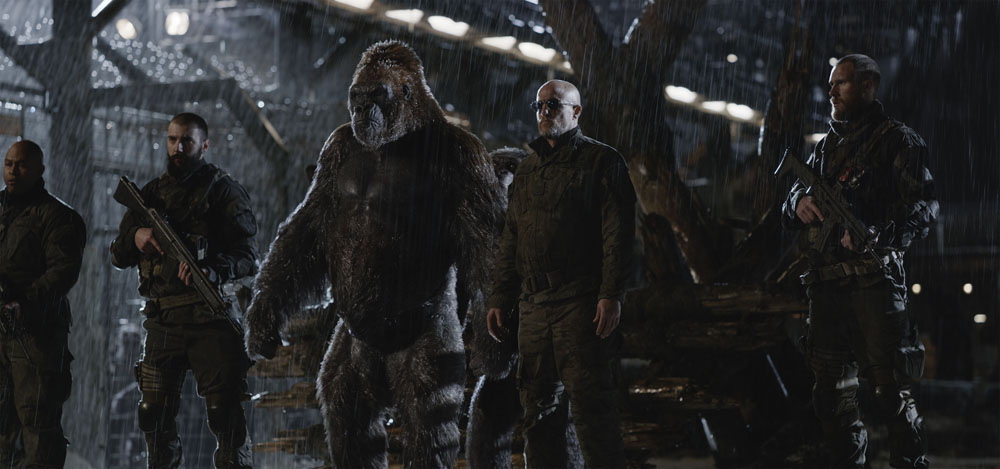
We have a scene where our main characters are saying goodbye to each other, but we found that at that moment it was slowing down the action. Not only that it, but it becomes redundant because that happens again later. It was one of my favorite moments by the two actors, but it was really slowing us down. So then you lose that. But you only know that once you see the picture as a whole. When you read the script you say, “Oh yeah. We need that because those two characters are the bedrock of this whole franchise.” But then you say, “No, we don’t. Because at this moment we don’t care about this. This is what’s going on at this moment, so we want to get past this. What is the important thing here? It’s Caesar’s quest at that moment.” And so we want to simplify it and refine it to that point where we modified the scene. So yes: we did lose lines for sure… entire scenes.
I agree about what you said earlier: that if you have great actors, they can say so much with just their face – with just that performance. That’s what can eliminate an entire scene. If you cut from his reaction and his reaction then tells you what the next scene was going to be about. When you read the script you think, “Oh my God. We need to see our hero get angry and then go on the road.” OK. But I have it in this close up. I have it and I can just cut this entire scene right out of the movie. What I’m left with, if I cut him at the right moment, he’s fuming he’s holding his son and he’s worried for the fate of his people.

And that’s what the next scene was about. But he already said it – not in so many words: I’m worried for the fate of my people but I have to go and do this. But he says it all with his face and you understand that when we come to the next scene and you see what he’s doing you realize, “I don’t need that scene to tell us this.” With a script you want things laid out for you sometimes. I think the written word is different than film obviously because you get so much out as you’re watching. You’re forming all these ideas and it points to one direction. I think as an audience we are very impatient to get moving. There’s a tendency to try to repeat things to make sure the audience gets it… but yeah, I got it… move on.
HULLFISH: Exactly. You’ve worked on a lot of action and VFX pictures, but the only way to get these pictures to work is through the performances and the emotion, and caring about character, right?
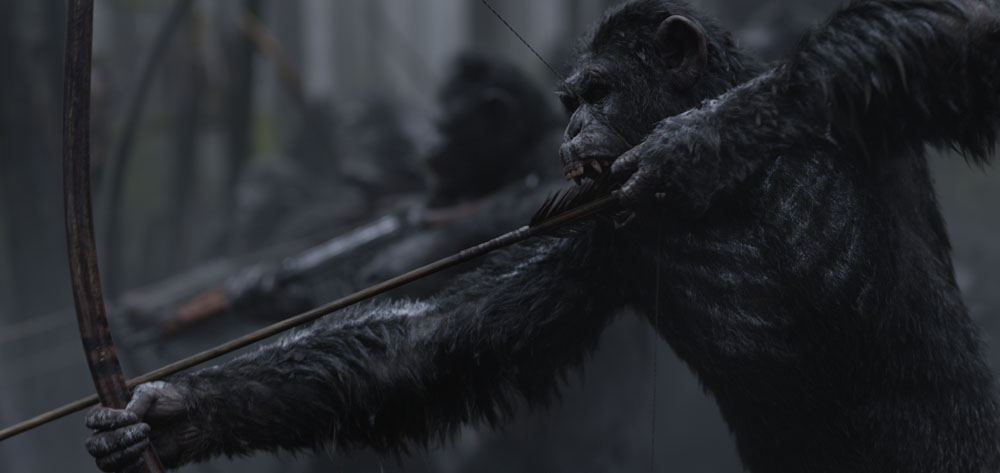 HOY: You know we have a tendency as editors to get typecast in a certain way. I’m proud that I’ve done a bunch of FX or action movies. But there’s something that lies underneath that which is performance and character and emotion and story. And the best battle scenes in any movie and hopefully ones I’ve worked on – is character, and if you don’t care about the characters then your battle scene becomes just noise and action. But if you care about your character and you have taken the time to build that, then you really care about what’s going on and you can cut to one look from our hero or the villain and you know exactly what’s going on and you’re invested in these characters. You have to build that into your editing somehow. I’ve been asked, “So, what is your editing style?” I don’t really have an editing style but I’m hoping my style or whatever I do is what the picture is in need of. And hopefully that comes out of intuition and that comes out of trying to get the best out of the story and the characters.
HOY: You know we have a tendency as editors to get typecast in a certain way. I’m proud that I’ve done a bunch of FX or action movies. But there’s something that lies underneath that which is performance and character and emotion and story. And the best battle scenes in any movie and hopefully ones I’ve worked on – is character, and if you don’t care about the characters then your battle scene becomes just noise and action. But if you care about your character and you have taken the time to build that, then you really care about what’s going on and you can cut to one look from our hero or the villain and you know exactly what’s going on and you’re invested in these characters. You have to build that into your editing somehow. I’ve been asked, “So, what is your editing style?” I don’t really have an editing style but I’m hoping my style or whatever I do is what the picture is in need of. And hopefully that comes out of intuition and that comes out of trying to get the best out of the story and the characters.
I’ll watch a movie and it can be very simply shot – wide shots… close ups. But if the story and the characters are involving. I’m just drawn into this for an hour and a half. Story absolutely is the most important thing. I can’t remember a movie I’ve seen where I thought, “The story was terrible, but I loved it because Wow what a spectacle!”
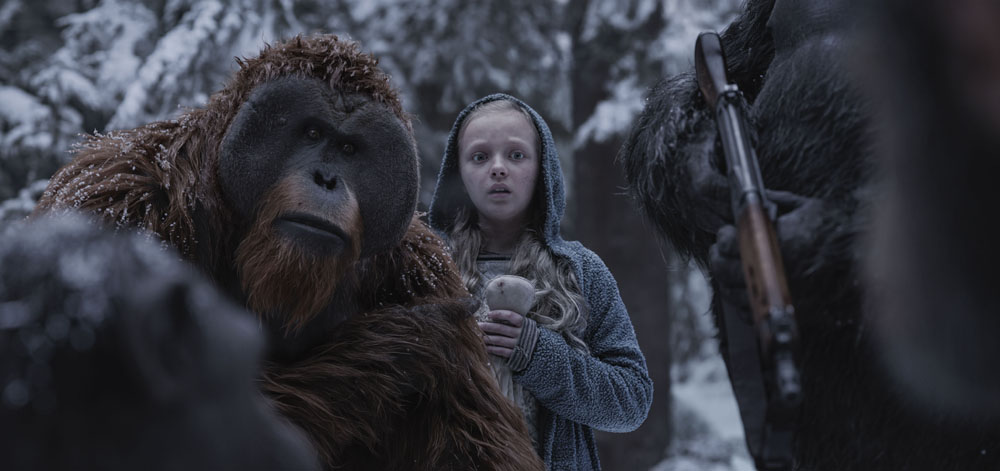
HULLFISH: But building that concern for a character has to be so hard when you’re dealing with characters you don’t really even get to see until later.
HOY: I go by faith that whatever I’m envisioning – that that’s going to be part of what’s going to end up on the screen. So I’ll look at a shot and there will be nothing in there…
HULLFISH: Like a plate.
HOY: Like a plate. It’s just a shot moving across the mountains and at some point there are going to be some apes on horseback going across there … or we’re looking at a green screen. We’re looking at two actors and they’re saying goodbye and behind them there’s this enormous army. So I look at them and think, “Well, how long do I stay on this? Is it a transitional moment? Is it an establishing moment? Is there emotional value? How long do I stay on the shot? With the plate shot of the apes traveling: look where they are in the wilderness. Where have they gotten themselves into now?
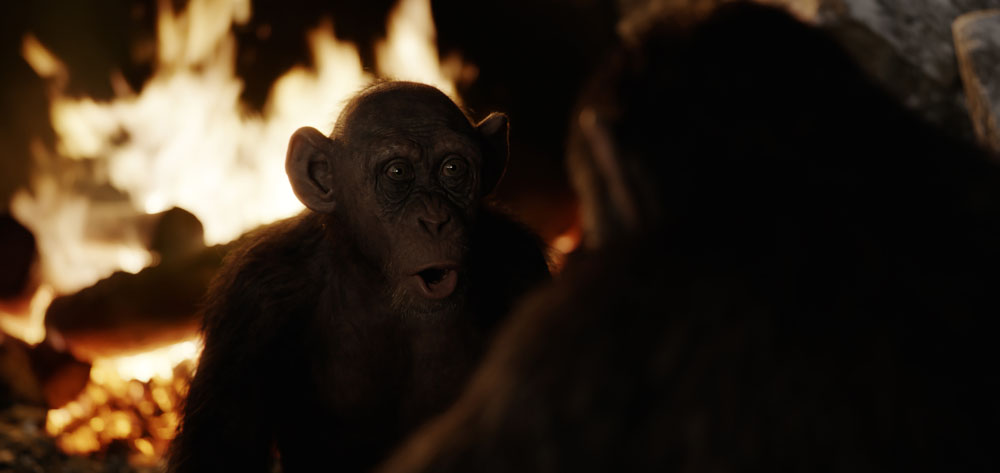
The other thing is emotional. It’s an army leaving and these two characters are framed in front of a huge army that’s waiting for them – probably to go to their death – so you want to stay on that longer and just let that play out and your eyes can do the searching for you. So in those two instances, that would be the idea of pacing. The pacing has to do with the dialogue and dialogue scenes – regardless of whether you have heavy visual effects – that pacing is based on what type of a scene it is. Do I want to sit there and watch their eyes and just be really absorbed with these characters? Because if I cut away, it’s going to ruin that moment. It’s going to be artificial. But if I just stay on that, that’s amazing. I don’t need to cut. This is where the moment is, right here.
In a battle scene, there’s a rise and fall to it. You’re pacing it and then you get to the height of the battle. How far can you go? The sound is now maximum. The music is maximum. The pace is cutcutcutcutcut. Where do you go? I like to go to the character. What’s he seeing? How’s he feeling about this? So when the opportunity presents itself, there have to be these moments where, “Oh my God! There’s something else happening in this battle or something’s happening in this character’s head. Something is happening other than just shooting people, dying, suffering or characters witnessing it. So how does that play out? Do I play that out in his head? Do I play that out in silence?

I have to find another way to transcend that moment which is: I think I’m reaching the climax but NO, NOW I’m into somebody’s head. Those are the kind of things that, as far as pacing is concerned, it fascinates me, because I actually love those little moments where you can you can insert something that is unexpected where you think, “What? Where are we now? Wow! I didn’t think I was going to feel this during this battle scene.” So those are some instances, as far as pacing, but when you see the picture as a whole you think, “OK, we have to tighten this area because I really don’t want to get bogged down here. What’s happening here is really oppressive, but we don’t want the picture to slip into oppressiveness. We want our hero to go through the pain and suffering, but we don’t want to dwell there for a long time because for an audience: “I get it. He’s suffering. Can we move on now?”
HULLFISH: I would think that it’s hard to screen some of these scenes with so many VFX and temp motion-captures as “stand ins.”
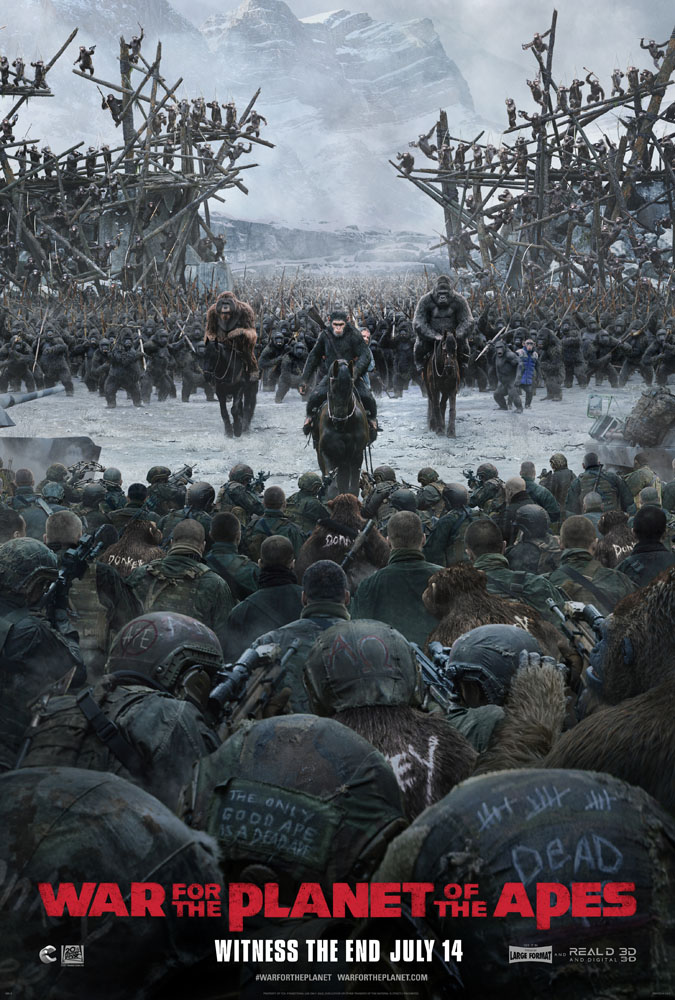 HOY: Sometimes you get art work: “Your king is leading an army and there is this army behind them and it’s an open field.” You want to make sure that you sit on that long enough so that you absorb it all. In that case, I stayed on it so that I would have our characters do most of the action in this wide shot and then much later go in to a close-up or more coverage. In other situations, maybe I wouldn’t if the visuals didn’t support the emotion of the scene. If there’s nothing more to get from the wide shot, let’s go in to a close-up and get the emotions there. But if, with the wide shot, you did get the emotion, because it was a spectacle, then you’re fine. Here are these two characters who are reduced to less significant things in this vast landscape.
HOY: Sometimes you get art work: “Your king is leading an army and there is this army behind them and it’s an open field.” You want to make sure that you sit on that long enough so that you absorb it all. In that case, I stayed on it so that I would have our characters do most of the action in this wide shot and then much later go in to a close-up or more coverage. In other situations, maybe I wouldn’t if the visuals didn’t support the emotion of the scene. If there’s nothing more to get from the wide shot, let’s go in to a close-up and get the emotions there. But if, with the wide shot, you did get the emotion, because it was a spectacle, then you’re fine. Here are these two characters who are reduced to less significant things in this vast landscape.
You want to be able to make use of all of the tools that you have at hand, so let’s maximize this because soon enough I’m going to be in on a close-up.
There are certain steps along the way before you actually commit yourself to X amount of thousands of dollars for a shot There are shots where things are moving and you have to imagine: “How long does it take for the arrows to travel until they get there?” After a while you can come pretty close to a few frames of guessing those timings.
I co-edited with Neil Travis and back in the film days and he would measure out a piece of film from his nose to arm’s length and with a wink say to me, “That’s the length of a reaction.” Roughly two and half seconds. So that’s one guideline to how long a shot might play.
Every frame costs thousands of dollars. On Dawn an ape shot was $60,000 a shot. (More for shot length over 5 seconds.) I think it’s slightly less on this one just because of the way it was budgeted and they figured out how to do it for less, but that’s really expensive. And we have over fourteen hundred ape shots.
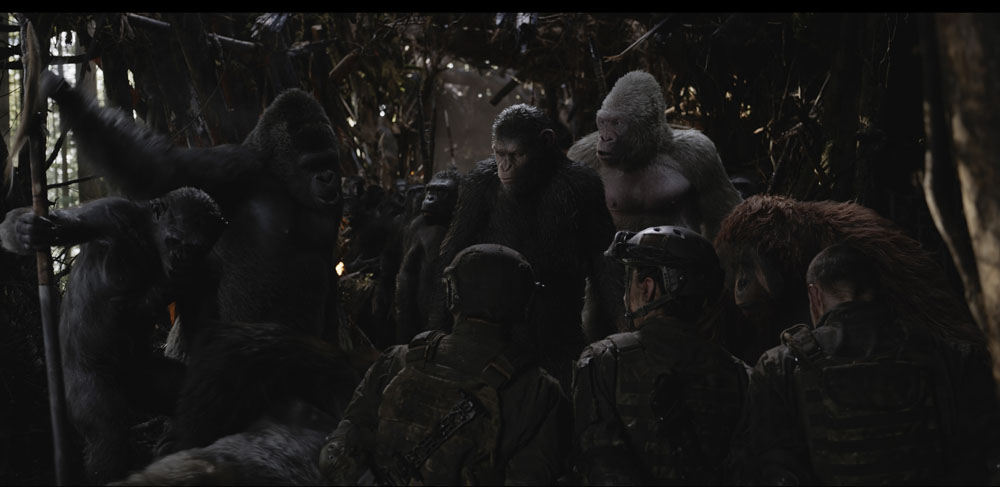
I worked with young editors and assistant editors and I tell them, “You’re paid to have an opinion.” You’re not paid to be a pair of hands. Go in there saying, “This is what I think it should be.” They want that opinion. Hopefully I bring things to the movie that the director may not have thought about. What I like to do is tell the director after principal photography, “Please take a break for 10 days, two weeks and come back and I’ll show you the movie. I’ll try to put as much music as I have time for and sound effects and I’ll show it to you and you sit here and watch it with some objectivity and then decide what do we do with the picture as a whole.”
With most directors, I’m on location. I’m showing them scenes as I go, so they know the performances are being captured the way they want. So when they see the picture as a whole, then we can talk about any differences of opinion. The director may say, “I intended to start the scene with this shot instead of this one.” We can work that out and we can talk about why. Ultimately, we can cut it the way he originally visualized, but there have been times where they say, “I actually like what you did before. Let’s go back to that.” That’s having a point of view and an Avid and being able to save all those versions. It’s a real plus, because on film, when you re-cut, those original choices disappear. The director needs to have a vision for the movie as a whole, and so I try to help bring that vision to the screen. If I have a difference of opinion, it’s only because I want what’s best for the picture. And as long as the director knows that, they’re OK with it. It’s not because I like it that way. It’s not because I cut it that way. It’s because that’s what’s best for the picture.
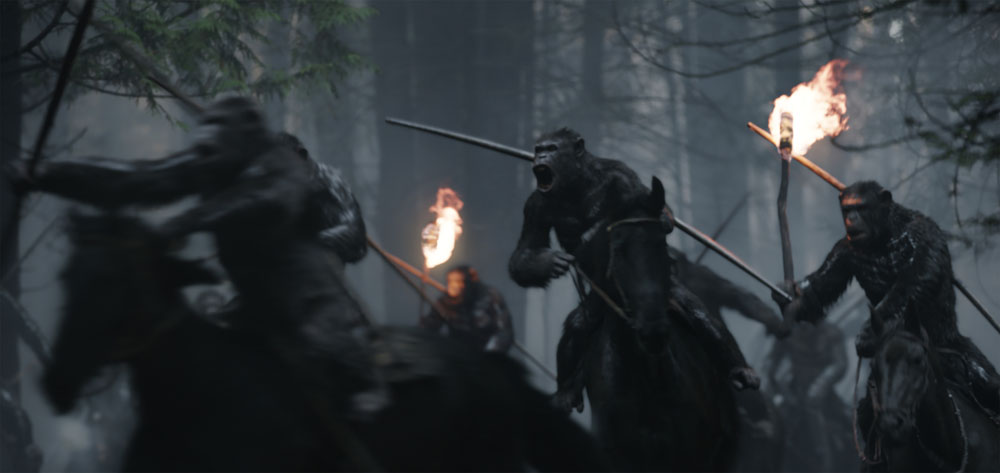
HULLFISH: It’s nice to have trust in a person, but if you both trust that what you both really want is for the good of the picture, you’ve got a solid foundation for solving any disagreement. How do you have your assistants set up your bins?
HOY: Basically in the same alphabetical order they shot the setups, so I know where the shots will be. I like to have my bins set up in Frame view. My assistant will also choose a representative frame for each shot that best represents that shot, so when I just look at the clip, I see, “ That’s the wide shot and there’s the close up, and there’s the over the shoulder.”
Also the director will choose select takes and the assistants will put a checkmark beside that take. We print everything. (meaning non-selected or B-neg shots are in the bin just like any other shot)
I watch all the dailies straight through and then I’ll go back to the daily bin. I put markers on moments that I think might be the foundation of the scene. The assistants put them in the bin in a straight line, and if I like one more than the others, I just nudge it up a little higher in the row. We also have assistants building selects reels, where every setup and take of a specific line plays back to back. So if I wanted use another performance or to replace a word I can go in there and see if it’s clearer somewhere else.
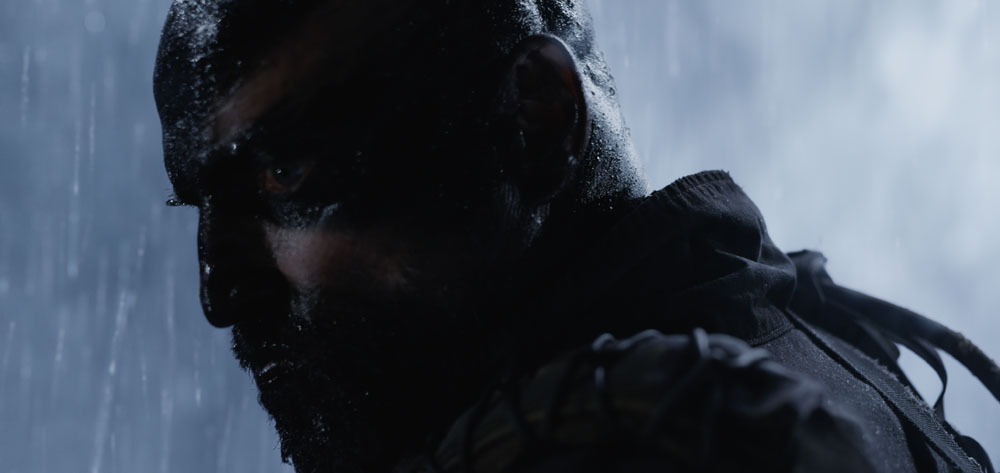 But that’s only in the refining process that I use the select reels. There are times when there are certain moments that will be the backbone of the scene. There are some moments that you say, “I somehow have to have this moment in here and action-match doesn’t matter. I need to get to this moment.” So I approach the scene – what I call “from the inside out.” I don’t start at the beginning and move through, instead I’ve got to get to this moment so I’ll start putting it together knowing that the scene is going to progress so that I can reach that moment.
But that’s only in the refining process that I use the select reels. There are times when there are certain moments that will be the backbone of the scene. There are some moments that you say, “I somehow have to have this moment in here and action-match doesn’t matter. I need to get to this moment.” So I approach the scene – what I call “from the inside out.” I don’t start at the beginning and move through, instead I’ve got to get to this moment so I’ll start putting it together knowing that the scene is going to progress so that I can reach that moment.
Then I can start thinking about the rhythm of what that scene might be. There might be two of those moments – and I’m basing it on performance. Obviously when it’s an action piece: What is the best piece of action that got him from point A to Point B? What shows him doing this best? What shot do I have of the sword going through. What’s the best and quickest shot that I can use that to depict this particular moment. Those things are what you discover when you begin to put an action piece together. Then I start putting just the dialogue tracks and the picture together. And when I feel that scene is ready for some sound effects or some temp music I’ll start laying some of that in. At which point, if the director’s around and I think it’s ready to show him, then I’ll show it. Sometimes he may want to see a scene really quickly because of some concerns he may have about it and I’ll have to show it before I feel it’s ready, but I am loathe to show a director something that is not really polished, because it’s not fair to me. It’s not fair to the director either, because they’re very self-aware. They don’t want to come in and look at something and think, “Oh my God! That’s not working! Is it me? … Or is it you?” Right? So you don’t want to do that. You want to have it to that point where you can analyze: How are the characters working? How’s is the story working? How’s this scene working?
So once I start putting scenes together then other scenes will begin to come in, but now I get to see how he starts the next scene. So, I might have to go back and rework the scene that I had leading into this scene because the transition doesn’t work. You have to keep in mind what the transitions are going to be into the next scene and that’s an ever-evolving thing, because if you eventually lose that scene, now you’ll need to make a different transition to the next scene coming in. So that’s an ongoing thing.
As we go through I’m trying to imagine – based on the script – what the next scene is going to be and how he might approach that. And at some point you will have something resembling the movie which is always amazing and surprising to me.
HULLFISH: So at the point you have the entire movie together, do you find it useful to watch that as a whole from beginning to end? Because in the 100 interviews I’ve done, there is not complete agreement. There are some who feel they want to hold off on viewing the whole movie, because it affects their ability to remain objective about the story as a whole.
HOY: I certainly agree that objectivity is your best ally and that we lose objectivity because we’re into the minutia and it’s hard to maintain that objectivity. My first impression is when the picture is finally put together and I have a chance to sit there and watch it with the director, because, up until that moment, I probably have not watched the picture entirely myself because I just haven’t had the time to. I’ve certainly watch a better part of it but I don’t know how the picture is progressing, so to watch the movie and to have that impression … I try to hold on to some of those first impressions that I have so that it continues to inform me later on. I can see what those other editors are talking about, but for me, and any director I’ve worked with, I’ve never experienced that.
The other important thing with these big VFX movies is that we have to begin to turnover our visual effects. How do we know what we actually need from the visual effects if I haven’t seen the picture in total? That could cost a lot of money down the line, because we could discover that we can or must cut entire scenes of visual effects. And for pictures where the budgets are so huge, it adds up real quick. So discovering that you can delete an entire scene can save a lot of money.
I’ve mixed this film in my Avid for all the screenings. We got 5.1 surround tracks from our sound design team. The temp music editor, Paul Apelgren is part of composer Michael Giacchino’s team.
I’ve actually mixed the picture eight times. For the studio alone, we screened it probably four times, five times easily. There was one time where I was rushing to get the picture finished for the screening the next day and after the screening, Matt asked me what I thought and I said, “I didn’t think anything, because I didn’t get anything out of that screening, because I was so worried about technical stuff.” Sometimes the objectivity comes in for me by just removing myself from that normal seat or that usual theater. So we took it from a theater which was right downstairs from our editing room and went to the huge Zanuck theater on the Fox lot. It was just the director and the two editors sitting and watching the movie, and because I already knew the picture was in sync – that it was supposed to play the way it was supposed to play – that I could actually sit and watch the movie and see it as objectively as I could. Sometimes when I’m screening for an audience I’m so worried that some critical thing is going to happen and spoil the screening and all the work we’ve put in just to get to this moment will be ruined – that’s always in the back of my mind. Once I know the screener is OK, I can actually become an audience member again so that really helps.
HULLFISH: The other thing is just getting away from the editing controls, right? Just the fact that you can’t hit pause and fix something completely changes the experience of watching the movie.

HOY: It completely does. In my cutting room I have my Avid set up with a 43 inch plasma on my right. So for the most part that’s where I watch it. But I also have a 65 inch to the side with it’s own dedicated sound system. So you hit a button and I play it over there. So just by me turning around and not being able to get close to my mixing board and the volume controls and not be distracted by the Avid screens and just dedicating myself to the picture as a whole, that gives me some objectivity. It’s just a matter of changing seats – getting out of my Aeron chair into a couch just feels different right there.
HULLFISH: Can you remember any of the things that you temped with?
HOY: Paul Apelgren the music editor, he was also on Dawn and I’d stayed in touch with him, so when I came back to LA to edit, he asked, “So what music have you been listening to?” When I’m editing I like playing music in the background even though I’m not cutting to it. I said, “It’s a funny thing. I’ve been listening to a lot Ennio Morricone especially his spaghetti westerns and I’ve been listening to Nick Cave, so I don’t know how that works.” And he says, “That’s an Interesting mashup between Morricone and Nick Cave.” It’s a funny thing because as Caesar takes off on this quest it becomes this epic Western. There is a hint of that in certain places which I hope that I brought some of that to it, but I also talked to the director and tell him, “I’ve been listening to this and this.” and he says, “Yeah. I can see that.” Paul also temped with a lot of the music from the Dawn movie, so there was a lot of Michael Giacchino’s music in there, but we also used different composers, like (Alexandre) Desplat. Paul found a wonderful cue from Snow Falling on Cedars.
Sometimes I like to temp the whole picture, but this picture really needed my attention elsewhere, so honestly, I trust Paul. He did an amazing job on the temp score, so I only chose maybe five or six cues. One of the cues I cut in is where Caesar is walking in what we call the trench. After the first battle he’s seeing the devastation on his apes. So I put this piece in there from some Junkie XL who did Allegiance and Divergence. I played it for Matt and he says, “This is a great piece, who’s this from?” And I say, “Junkie XL.” He said, “No!” But that piece stayed in there for the longest time.
HULLFISH: Can you tell me anything about these two scenes from the movie?
HOY: What I find interesting is what both scenes have in common – the lighting. In the scene with Bad Ape, Maurice and Nova it’s lit with flashlights. The performances that were chosen have a natural light to the little girl and our motion capture actors which WETA then had to replicate how the light would interact on Maurice and Bad Ape’s fur and clothing.
In the scene between Caesar and the Colonel (Woody Harrelson) there is a searchlight moving behind the Colonel in the background. Only the light hitting our actors was evident in the raw footage, there was no background. When we began to have discussions about the background we had to determine a believable motion of the searchlights because the interactive lighting was visible on the Colonel’s shaved head and Caesar.
Also in these two scenes if you were to watch the raw motion capture version and the finished scene you will see the amazing performances of our actors.
HULLFISH: Thanks so much for talking with me today. I really enjoyed our conversation.
HOY: Me too. Good to talk with you. We need to meet some day.
This interview was transcribed using Speedscriber.
To read more interviews in the Art of the Cut series, check out THIS LINK and follow me on Twitter @stevehullfish
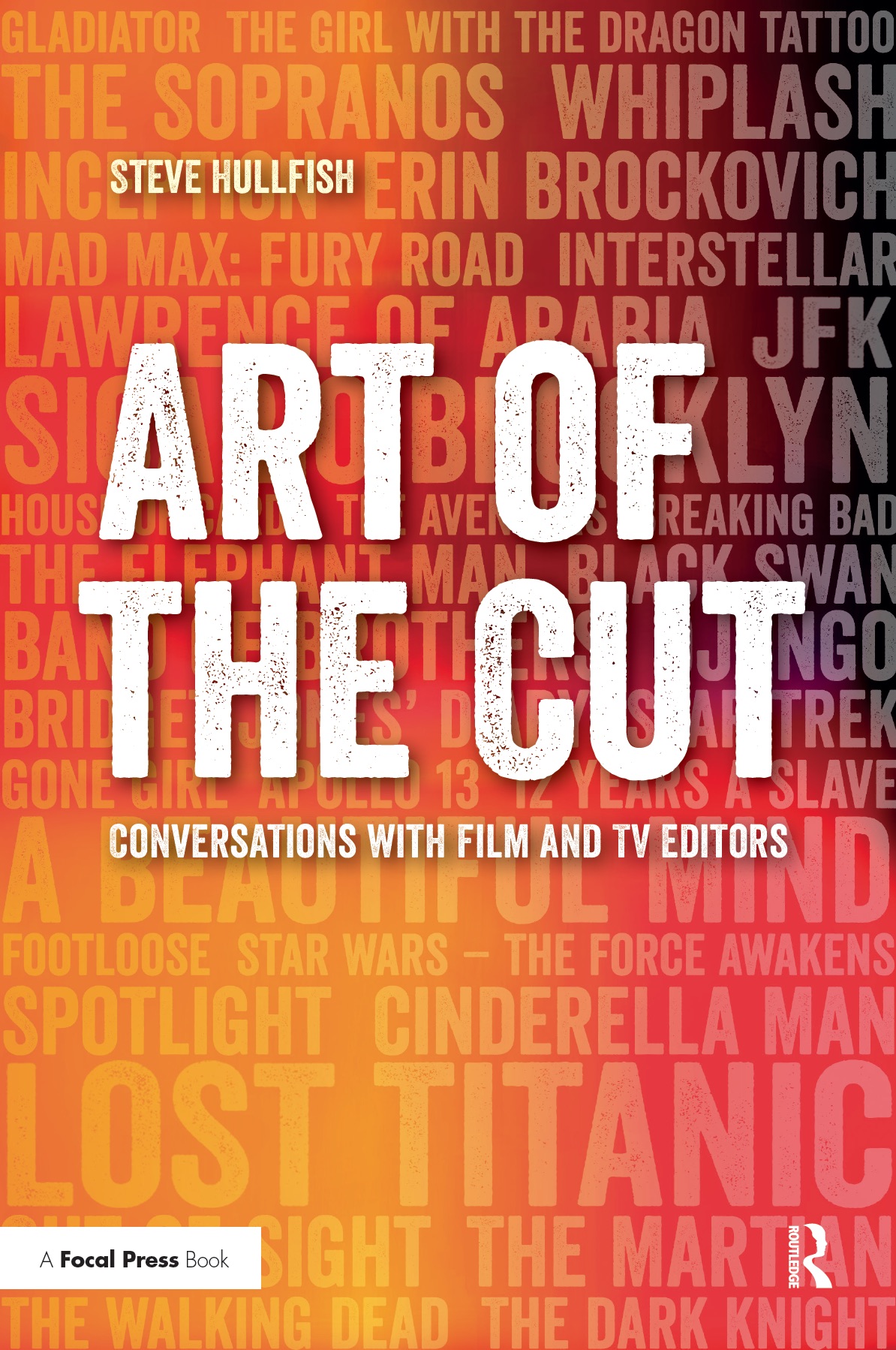 The first 50 Art of the Cut interviews have been curated into a book, “Art of the Cut: Conversations with Film and TV editors.” The book is not merely a collection of interviews, but was edited into topics that read like a massive, virtual roundtable discussion of some of the most important topics to editors everywhere: storytelling, pacing, rhythm, collaboration with directors, approach to a scene and more. Oscar nominee, Dody Dorn, ACE, said of the book: “Congratulations on putting together such a wonderful book. I can see why so many editors enjoy talking with you. The depth and insightfulness of your questions makes the answers so much more interesting than the garden variety interview. It is truly a wonderful resource for anyone who is in love with or fascinated by the alchemy of editing.” MPEG’s Cinemontage magazine said of the book: “In his new book, Art of the Cut: Conversations with Film and TV Editors, he gathers together interviews with more than 50 working editors to create a mosaic of advice that will interest both veterans and newcomers to the field. It will be especially valuable for those who aspire to join what Hullfish calls, “the brotherhood and sisterhood of editors.”
The first 50 Art of the Cut interviews have been curated into a book, “Art of the Cut: Conversations with Film and TV editors.” The book is not merely a collection of interviews, but was edited into topics that read like a massive, virtual roundtable discussion of some of the most important topics to editors everywhere: storytelling, pacing, rhythm, collaboration with directors, approach to a scene and more. Oscar nominee, Dody Dorn, ACE, said of the book: “Congratulations on putting together such a wonderful book. I can see why so many editors enjoy talking with you. The depth and insightfulness of your questions makes the answers so much more interesting than the garden variety interview. It is truly a wonderful resource for anyone who is in love with or fascinated by the alchemy of editing.” MPEG’s Cinemontage magazine said of the book: “In his new book, Art of the Cut: Conversations with Film and TV Editors, he gathers together interviews with more than 50 working editors to create a mosaic of advice that will interest both veterans and newcomers to the field. It will be especially valuable for those who aspire to join what Hullfish calls, “the brotherhood and sisterhood of editors.”
Check out the editing on some other big-budget features like Pirates of the Caribbean 5, Transformers: TLK, Guardians of the Galaxy and Wonder Woman
Or if you prefer, some documentaries: OJ: Made in America, or a lower-budget indie: Colossal.

Filmtools
Filmmakers go-to destination for pre-production, production & post production equipment!
Shop Now